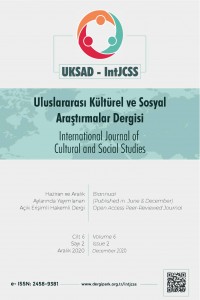Öz
Kaynakça
- Alejandro De Le Garza. (2019). Roma filminin gerçek hikâyesi. Retrieved November 28, 2019, from https://hakikatadalethafiza.org/roma-filminin-gercek-hikayesi/
- Bayad, Aydin. (2016). Erving Goffman’ın Benlik Kavramı ve İnsan Doğası Varsayımı. Psikoloji Çalışmaları, 36(1), 81–93.
- Cuarón, Alfonso. (2018). Roma. Mexico.
- Demircan, Birol. (2020). International Perspectives on Feminism and Sexism in the Film Industry. In International Perspectives on Feminism and Sexism in the Film Industry (pp. 200–211).
- Goffman, E., & Cezar, B. (2016). Günlük yaşamda benliğin sunumu.
- Hamnett. B. R. (1999). A Concise History of Mexico. Cambridge University Press.
- Sigurjónsdóttir, S. D. (2003). Hofstede’s dimensions and their relations to magazine advertising. University of Akureyri, 1–48.
- Şule Oğuz, H. (2006). STUART HALL Tarihten Geçenler. https://doi.org/10.17572/mj2014.1.125136
- Weissenrieder, M., & Fairclough, N. (1997). Critical Discourse Analysis: The Critical Study of Language. The Modern Language Journal (Vol. 81). https://doi.org/10.2307/329335
Öz
The issue of which mechanisms are effective in determining people's behaviors in social life has been a subject that has been discussed for a long time. Consensual self presented during interactions, the self shaped as a result of the audience's practices and the player self are all at the same time inherent in each individual. Because as soon as the individual interacts with the other, s/he actually comes to a scene in front of the others and interacts by conveying some things in this scene and by not transmitting or covering some aspects. In this study, the Roma movie and the caharacters are analyzed according to critical discourse analysis method and the cultural representations presented in the movie are uncovered through the use of Hofstede's cultural dimensions. A historical background of Mexican history is provided in order to unravel the political instances in the movie. It turns out that the Roma movie skillfully brings together the experiences of Cleo, a Mexican native maid, in the light of both family conflicts and worrying social events in the complex political environment of the 1970s.
Anahtar Kelimeler
Roma minority Mexico culturalrepresentation criticaldiscourseanalysis
Kaynakça
- Alejandro De Le Garza. (2019). Roma filminin gerçek hikâyesi. Retrieved November 28, 2019, from https://hakikatadalethafiza.org/roma-filminin-gercek-hikayesi/
- Bayad, Aydin. (2016). Erving Goffman’ın Benlik Kavramı ve İnsan Doğası Varsayımı. Psikoloji Çalışmaları, 36(1), 81–93.
- Cuarón, Alfonso. (2018). Roma. Mexico.
- Demircan, Birol. (2020). International Perspectives on Feminism and Sexism in the Film Industry. In International Perspectives on Feminism and Sexism in the Film Industry (pp. 200–211).
- Goffman, E., & Cezar, B. (2016). Günlük yaşamda benliğin sunumu.
- Hamnett. B. R. (1999). A Concise History of Mexico. Cambridge University Press.
- Sigurjónsdóttir, S. D. (2003). Hofstede’s dimensions and their relations to magazine advertising. University of Akureyri, 1–48.
- Şule Oğuz, H. (2006). STUART HALL Tarihten Geçenler. https://doi.org/10.17572/mj2014.1.125136
- Weissenrieder, M., & Fairclough, N. (1997). Critical Discourse Analysis: The Critical Study of Language. The Modern Language Journal (Vol. 81). https://doi.org/10.2307/329335
Ayrıntılar
| Birincil Dil | Türkçe |
|---|---|
| Bölüm | Araştırma |
| Yazarlar | |
| Yayımlanma Tarihi | 31 Aralık 2020 |
| Gönderilme Tarihi | 25 Şubat 2020 |
| Kabul Tarihi | 21 Aralık 2020 |
| Yayımlandığı Sayı | Yıl 2020 Cilt: 6 Sayı: 2 |
Uluslararası Kültürel ve Sosyal Araştırmalar Dergisi


